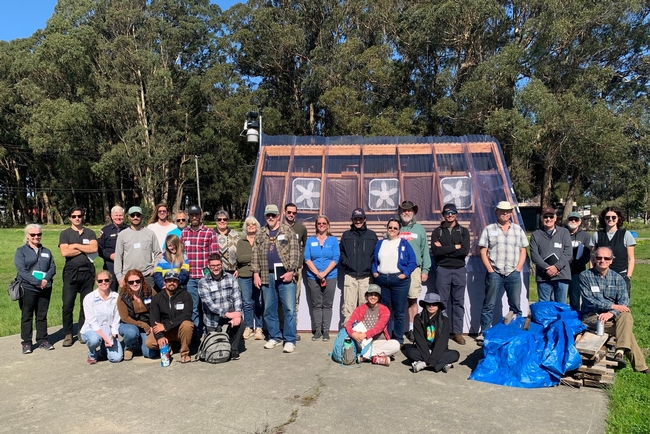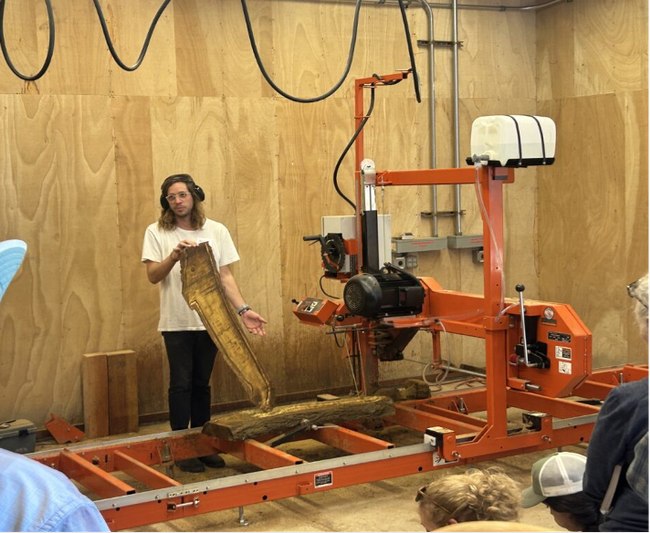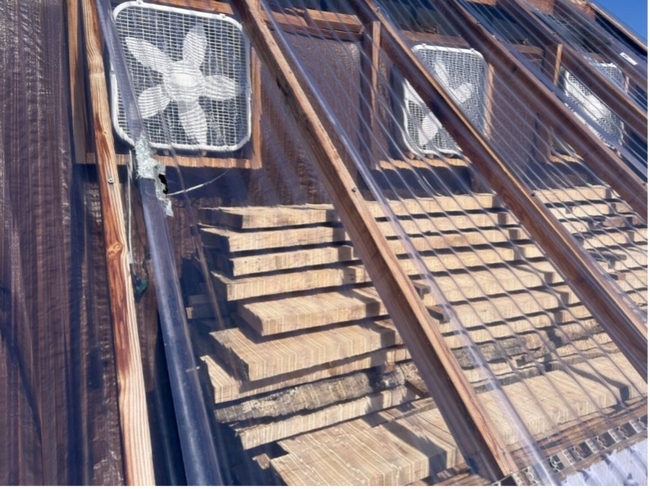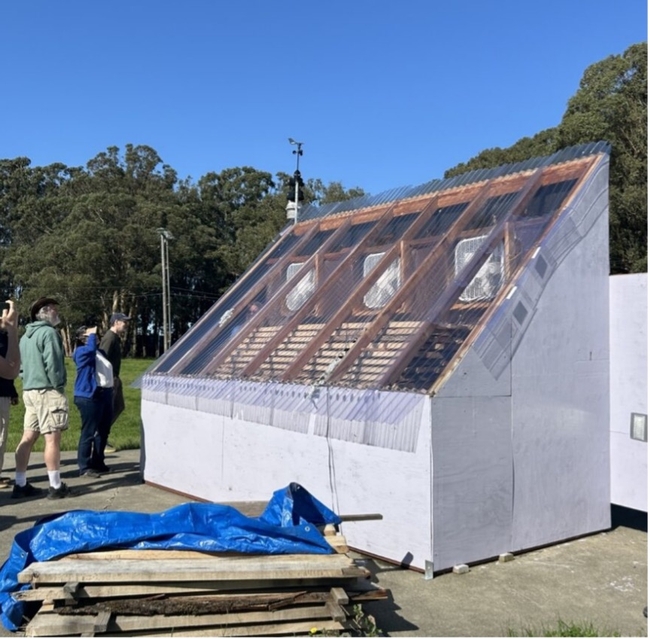Today, the revitalization of the UC Wood Products laboratory at the Richmond Field Station outpost is led by Berkeley's UCCE Assistant Professors and Extension Specialists Dr. Daniel Sanchez and Dr. Paul Mayencourt.
Sanchez leads the Carbon Removal Lab and his work advocates for the adoption of innovative biomass utilization technologies, which encourages policymakers and industry leaders to learn, collaborate and support utilization of woody biomass and wood products. Mayencourt researches the utilization of underutilized small-diameter trees, and Californian native hardwoods, for structural applications in architecture and engineering.
The work and research that both Sanchez and Mayencourt are conducting is inspiring. The UCCE Forest Stewardship Team hosted a field day at Richmond to connect private forest landowners and natural resource professionals to the research at the Richmond Field Station. Participants learned about investing in portable sawmills, utilization of solar kilns, and explored potential uses of their own lumber for DIY creations.
Forest landowners and tour attendees Nora Jesh and Billy Batty recognize that managing excess woody material post-wildfire is one of their biggest challenges and is what inspired their participation in the Richmond Field Station tour. “We are constantly looking for ways to use our timber while reducing our property's fuel load,” said Jesh.
Tour Stop #1: Portable Sawmills
At the first stop in the tour, Mayencourt and Sanchez discussed the considerations of investing and operating a portable sawmill. The conversation highlighted the application of milling non-commercially valued timber, such as small diameter trees, for personal utilization and active forest management. Decreasing tree density, particularly small diameter trees, provides more growing space and reduces competition for larger trees to mature, therefore improving their resiliency in the face of disturbances. They demonstrated the use of the station's “Wood-Mizer” sawmill while milling an often underutilized native California hardwood, the tanoak.
Landowners considering investing in a portable sawmill are encouraged to think of how much material they intend to mill, and the feasibility of further wood processing. Also, there may be portable sawmill operation locally or an opportunity to invest in one as a community, depending on demand.
When asked how wood utilization can improve at the landowner and community scale, Batty and Jesh responded:
“Due to the high cost of logging and transportation to the big commercial mills, it's not really profitable for private landholders to have their timber harvested. But I could see some strong advantages to creating a local co-op type arrangement to buy a portable mill that could be brought to different sites. It just makes sense to do at least the first few levels of processing close to where the trees are. Transportation costs would be greatly reduced, and production could be tailored for local needs. And of course, it would generate profits for the local community. I've heard that there's a mill in the Midwest that pays big bucks for beetle damaged California pine, but why should we be shipping it halfway across the country only to be shipped back as the end product, leaving the profits behind?”
For more information on the broader economy of California's Forestry and Forest-Products Sector, please view our UCANR publication.
Tour Stop #2: Solar Kilns
Next, Mayencourt and Sanchez led the tour to a crucial step in wood processing – wood drying. Before cut wood can be utilized as manufacturing lumber, it must be dried to a specific moisture content. Since California's ambient humidity fluctuates too often for wood to be air-dried, a kiln is essential for lumber processing.
At the field station, Mayencourt constructed a greenhouse solar-kiln that extracts energy from the sun and exerts it to dry lumber. The simple plywood frame construction and south-facing plastic sheet rooftop with fans for air circulation is an approachable means for landowners to take a dive into processing their own lumber.
To explore more, view Virginia Tech's guide for solar kiln constriction.
Tour Stop #3: Wood Product Utilization – Mass timber and DIY
The tour concluded at the station's design and construction building, where Mayencourt and Sanchez research cost-effective and innovative uses of California's lumber, such as mass timber. Mass timber refers to an engineered-wood product, consisting of layers of wood fixed together via mechanical or adhesive joiners. By linking one layer of wood to another, the strength increases and allows it to be used for larger structural components in buildings.
There are different forms of mass timber fastening that do not require adhesives, such as nail-laminated (NLT) and dowel-laminated (DLT). Mayencourt and Sanchez noted that investments in mass timber act as a carbon-smart solution for California's building sector, provides economic value to resilient forest management projects, and reinvigorates the forest product industry in both urban and rural communities.
The most recent Joint Institute for Wood Product Innovations report identified actions and policies that support wood products innovation. Movement on this front can be seen as CAL FIRE invests $15 million in new Wood Products and Bioenergy Program. Sanchez hopes that further funding in innovative research in wood products, as well as state incentives and collaboration with private industry, will lead California into a new era of climate-smart forestry.
As for Jesh and Batty, their ambitions for DIY projects for the resort range from the practical to the fantastical:
“We are both huge Tolkien fans and have been since we were kids. We would love to carve the White Tree or the Gates of Moria into double doors for the lodge. Then use LEDs or glow in the dark resin to make them come alive at night. More realistic goals will be to make tables, chairs, and other smaller items for our rental cabins as we get them restored. We love the idea of furnishing the cabins with wood from the property instead of bringing in outside goods.”
Private forest landowners manage more than 40% of California's forests, and they play a critical role in the states' initiative to expand wood product utilization. Investing in avenues for private landowners to participate in the wood product and bioenergy sector would not only spur economic development in local communities, but also provide environmental benefits via forest health improvements.



